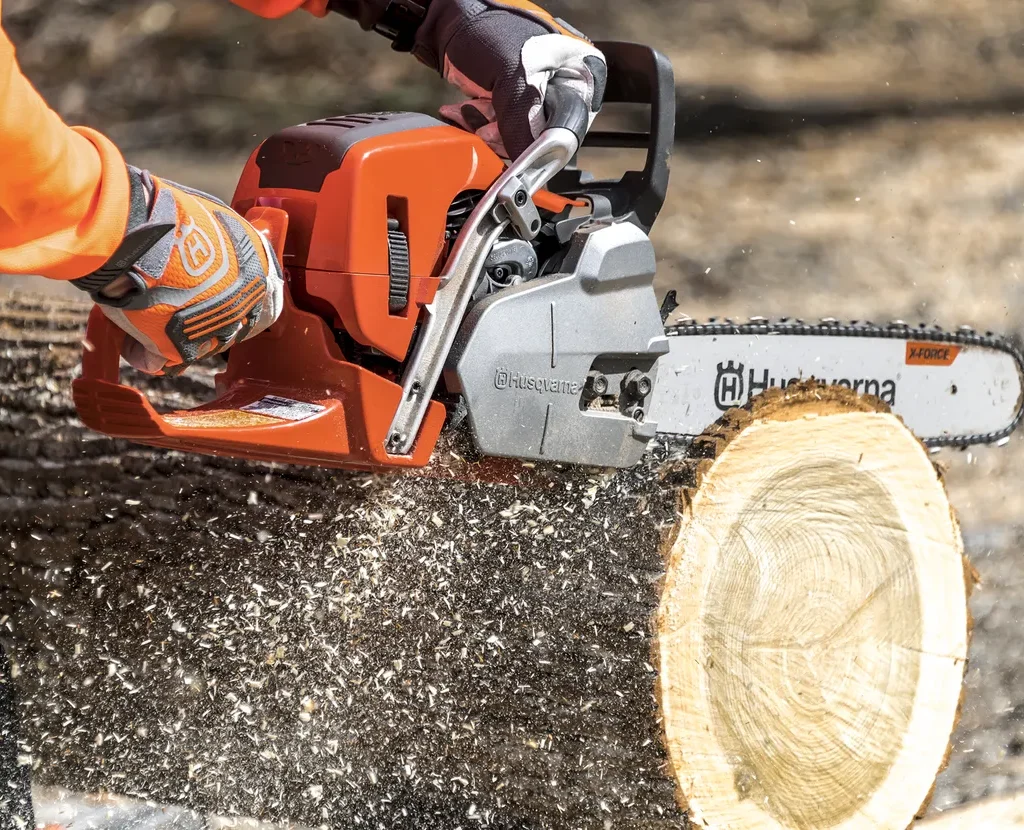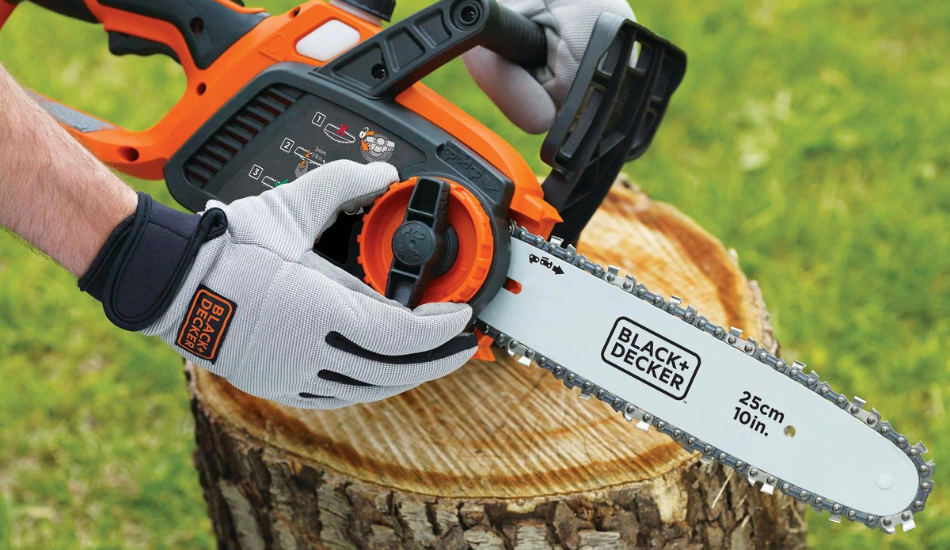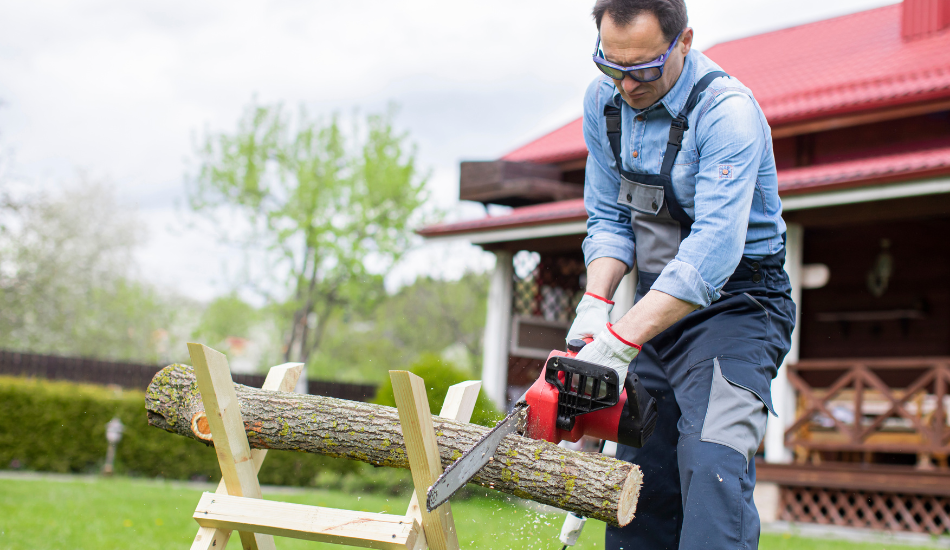In this article, we will share 7 essential chainsaw tips for beginners in 2024. We will cover everything from picking the right chainsaw for your needs and give you some tips on how to care for your chainsaw. Lastly, we will mention some common mistakes people make when using a chainsaw so that you can avoid these mistakes.
Content Breakdown
ToggleUsing a chainsaw might be difficult, especially if you a novice and never used one before. But if you have proper knowledge and techniques then a chainsaw can be a useful tool for your yard maintenance. Learning the basics of chainsaw will help you to complete any kind of outdoor project, cut firewood, or trim some overgrown limbs safely and efficiently. Let’s start our 7 essential chainsaw tips for beginners in 2024.
Tip 1: Understand Your Chainsaw

Before you start using your chainsaw, it’s important to understand the different types of chainsaws available and their basic components. So our first chainsaw tips for beginners is to understand the types of chainsaws. Here’s a brief summary:
Types of Chainsaws
Gas Chainsaws
Gas chainsaws are powerful and efficient, and they are best suited to large jobs such as cutting trees. They are also more expensive than electric chainsaws and require regular maintenance. If you don’t handle them properly, gas chainsaws can be a fire hazard. Gas chainsaws are also heavier than electric chainsaws, making them more difficult to handle.
Electric Chainsaws
Electric chainsaws are lighter and easier to handle than gas chainsaws. They also require less maintenance and don’t produce as much noise. Electric chainsaws are also cheaper to operate than gas chainsaws. However, this type of chainsaw requires a power outlet, which limits mobility.
Battery-Powered Chainsaws
Battery-powered chainsaws are more portable than electric chainsaws, as they don’t require power outlets. They are also quieter and easier to use, making them an ideal choice for small jobs. However, they are more expensive to purchase and maintain than electric chainsaws. In addition, battery-powered chainsaws require more frequent charging than other chainsaws.
Basic Components
Chain: This is the chainsaw’s cutting element. It moves around the bar and slices through the wood. The chain is lubricated with oil to prevent it from overheating. The chain also needs to be sharpened regularly to ensure efficient cutting.
Bar: The bar is the metal part of the chainsaw that holds the chain. It is connected to the motor and spins around as the chainsaw is running. The chain slides along the bar and cuts the wood. Chainsaw bars come in various lengths, which affect cutting capacity.
Engine/Motor: The power source of your chainsaw. Gas chainsaws have internal combustion engines, while electric and battery chainsaws have motors. Chainsaw engines and motors come in various sizes and powers. Different engines and motors offer different levels of power, speed, and efficiency.
Handles: The handles of a chainsaw are the parts that you hold when operating it. They should be comfortable and provide a secure grip. Handles should also be adjustable to suit your height and body type.
Getting familiar with these aspects will help you operate your chainsaw more effectively and safely.
Tip 2: Wear Essential Safety Gear

Next chainsaw tips for beginners is wear essential safety gear. Wearing the right safety gear can greatly reduce your chances of being injured when using a chainsaw. Here’s a rundown of the essential safety equipment you should always use:
Helmet
A chainsaw helmet protects your head from falling branches and debris. Look for helmets that include a face shield or safety visor to protect your face and eyes from flying dust.
Check out some top rated chainsaw helmets on amazon
- Oregon Chainsaw Safety Protective Helmet with Visor Combo Set
- Husqvarna Chainsaw Helmet with Metal Mesh Face Shield
- NEIKO Forestry Chainsaw Helmet with Shield and Earmuffs
Gloves
Chainsaw gloves should be thick and sturdy to protect against cuts and scratches. They should be made from a durable material that resists cuts and abrasions. Gloves also provide a better grip on the chainsaw, improving control.
Check out some top rated chainsaw gloves on amazon
- Oregon 91305L Chainsaw Gloves, Size 10 (Pack of 1)
- Wells Lamont mens Work Gloves, Tan, Large Pack of 1 US
- Mechanix Wear: Material4X M-Pact Synthetic Leather Work Gloves
Chaps
Chainsaw chaps are designed to protect your legs from accidental cuts. Made from tough, layered material, they can help prevent serious injuries if the chainsaw comes into contact with your legs.
Check out some top rated chainsaw chaps on amazon
- Husqvarna Technical Apron Wrap Chainsaw Chaps
- Oregon Protective Chainsaw Chaps for Cutting and Logging
- FORESTER Chainsaw Chaps For Men – Adjustable Belt – Chain Saw Chaps For Men, Apron Style
Ear Protection
Chainsaws can be very noisy, potentially causing hearing damage over time. Ear muffs or earplugs will protect your hearing and make it easier to focus on the task at hand.
Check out some top rated chainsaw ear protectors on amazon
- Husqvarna Professional Headband Hearing Protectors
- ProCase Noise Reduction Safety Earmuffs
- Dewalt DPG62-C Interceptor Protective Safety Earmuff Yellow/ Black
Eye Protection
Safety goggles or glasses protect your eyes from sawdust, debris, and kickbacks. Clear lenses are ideal for seeing your work clearly.
Check out some top rated chainsaw safety glasses on amazon
- Honeywell Uvex S1650DF Carbon Vision Safety Eyewear, Black/Grey
- 3M Professional Goggle, Clear Lens Provides Excellent Visibility
- 3M Safety Glasses for Men and Women, SecureFit 400
Wearing these safety gear items every time you use a chainsaw ensures that you’re protected from common risks and makes your cutting tasks safer and more comfortable.
Tip 3: Perform Pre-Use Safety Checks

Before starting any chainsaw, it’s essential to perform a series of pre-use safety checks to ensure that the tool operates safely and efficiently. This is very important chainsaw tips for beginners to avoid unexpected accidents. Here’s what you should inspect:
Check Chain Tension and Sharpness
Ensure the chain is properly tensioned. A loose chain can slip off, while a too-tight chain can cause excessive wear on the saw. Also, check the sharpness of the chain. A dull chain requires more force to cut and can be dangerous. Sharpen the chain if needed.
Ensure Proper Lubrication and Fuel Levels
Verify that the chainsaw’s oil reservoir is filled with the correct chain oil to keep the chain lubricated and running smoothly. Check the fuel level and make sure you’re using the right mixture of gasoline and oil if you’re operating a gas-powered chainsaw.
Inspect for Any Damage or Wear
Examine the chainsaw for any visible signs of damage, such as cracks, loose parts, or worn components. Ensure all screws and bolts are securely fastened. Address any issues before using the chainsaw to prevent potential accidents or equipment failure.
By conducting these safety checks before each use, you ensure that your chainsaw operates correctly and minimizes the risk of accidents or breakdowns.
Also Read: The 10 Best Lightweight Chainsaw for Easy Cutting
Tip 4: How to Use a Chainsaw for Beginners

Operating a chainsaw for the first time can be daunting, but with the right approach, you can manage it safely and effectively. Here’s a step-by-step guide to get you started:
Positioning and Stance
Stand with your feet shoulder-width apart for a stable base. Hold the chainsaw tightly with both hands—your dominant hand should be on the rear handle and your other hand on the front handle. Keep your elbows slightly bent to absorb any kickback and maintain control.
Starting the Chainsaw
If you have a gas-powered chainsaw, place it on the ground and engage the chain brake. Hold the front handle in one hand and pull the starter cord with the other. For electric or battery-powered chainsaws, ensure the chain brake is on before pressing the power button.
Cutting Techniques
Begin with smaller cuts to get a feel for the saw’s power. When cutting, keep the chainsaw close to your body for better control and balance. Use a steady, controlled motion, allowing the saw to do the work—don’t force the blade through the wood. Focus on cutting with the lower part of the bar, avoiding the tip to reduce the risk of kickback.
Emphasis on Control and Awareness
Always be aware of your surroundings. Watch for obstacles, and ensure you have a clear path to retreat if needed. Never operate a chainsaw above shoulder height or cut something in an awkward position.
The following steps will help you use a chainsaw safely and confidently. Start slow, focus on control, and always prioritize safety.
Tip 5: Learn Basic Cutting Techniques

Our next chainsaw tips for beginners is to learn some basic cutting techniques. These foundational skills will help you handle a variety of tasks safely and efficiently. Some basic cutting techniques below:
Crosscutting
This is the most common type of cut, where you cut across the grain of the wood, usually to cut logs into smaller pieces. To make a crosscut, position the log securely, either on the ground or on a stable surface.
Stand with your feet shoulder-width apart for balance, hold the chainsaw firmly, and let the chain do the work as you gently guide it through the wood. Avoid forcing the chainsaw; instead, allow it to cut at its own pace.
Felling
Felling refers to cutting down a tree. As a beginner, this should be approached with caution. Always plan the direction you want the tree to fall and clear the area of obstacles. Start by making a notch on the tree side, facing the direction you want it to fall.
This notch should be about one-third of the way through the trunk. Next, move to the opposite side and make a cut slightly above the notch. As the tree begins to fall, step back and to the side, never turning your back on the tree.
Limbing
Limbing involves removing branches from a felled tree. Start at the base and work your way up, cutting branches as close to the trunk as possible. Stand on the opposite side of the log from the branch you are cutting, and use the chainsaw to make controlled cuts. Always be cautious of branches that may be under tension, as they can snap back unexpectedly when trimming.
Proper Stance and Grip
For all cuts, your stance and grip are crucial for maintaining control. Stand with your feet shoulder-width apart and grip the chainsaw tightly.
Your body should be positioned slightly to the left of the chainsaw to protect yourself from kickback. Keep your elbows slightly bent, and always hold the saw with both hands for maximum control.
By practicing these basic cutting techniques, you’ll build confidence and improve your chainsaw handling skills, making your work safer and more efficient.
Also Read: The 10 Best Chainsaw for Cutting Trees: Your Ultimate Guide
Tip 6: Avoid the Most Common Chainsaw Accident
One of the most common and dangerous chainsaw accidents is kickback—a sudden, violent upward movement of the chainsaw, often caused when the tip of the bar makes contact with an object or when the chain gets pinched in the cut. Understanding kickback and how to prevent it is crucial for beginners.
What is Kickback?
Kickback happens when the moving chain at the tip of the chainsaw bar hits something solid, such as a branch, knot, or even another piece of wood. This contact can cause the saw to jerk back toward you, leading to serious injury. It’s the leading cause of chainsaw-related accidents, especially for those unfamiliar with the proper techniques.
How to Avoid Kickback:
Use Proper Cutting Techniques
Always use the lower portion of the bar, closer to the chainsaw body, for cutting. Avoid using the upper tip of the bar, which is the most common area where kickback occurs.
Maintain a Firm Grip
Always hold the chainsaw with both hands—one on the rear handle and the other on the front handle. This gives you more control and helps you react quickly if a kickback happens.
Keep the Chainsaw Chain Sharp
A dull chain increases the likelihood of kickback because it requires more force to cut, which can lead to instability.
Use a Chainsaw with a Low-Kickback Chain
Some chainsaws come with specially designed chains that reduce the risk of kickback. If you’re a beginner, it’s wise to invest in one of these models.
Position Yourself Correctly
Stand slightly to the side of the chainsaw, not directly behind it. This way, if a kickback occurs, the saw will miss you as it moves upward.
Tip 7: Choose the Best Chainsaw for a Beginner

Our last chainsaw tips for beginners is to find the best chainsaw for yourself. Selecting the right chainsaw as a beginner is crucial for both safety and ease of use. The best chainsaws for beginners are those that strike a balance between power, weight, and user-friendliness.
Types of Chainsaws to Consider
Electric Chainsaws
These are a great choice for beginners due to their lightweight design and easy start-up. They require less maintenance than gas-powered models and are ideal for small to medium tasks around the yard.
Battery-Powered Chainsaws
If you prefer cordless freedom, battery-powered chainsaws are excellent for beginners. They are quieter, require minimal maintenance, and are typically lighter. Plus, you won’t have to worry about gas or cords, making them easy to handle.
Gas-Powered Chainsaws
While these offer more power, they can be heavier and more challenging to manage for beginners. However, if you need to tackle more demanding tasks, a smaller, easy-to-start gas chainsaw could be a good choice.
Factors to Consider
- Weight: A lightweight chainsaw reduces fatigue and is easier to control, making it safer for beginners.
- Power: Consider a chainsaw with enough power to handle the tasks you plan to undertake, but not so much that it becomes difficult to manage.
- Ease of Use: Look for chainsaws with features like tool-free chain tensioning, automatic oiling, and ergonomic handles that make them more comfortable and easier to operate.
Bonus Tip – Regular Maintenance and Storage

Here are some bonus chainsaw tips for beginners regarding maintenance and storage the chainsaw. Keeping your chainsaw in top condition requires regular maintenance and proper storage. This not only extends the life of your tool but also ensures it operates safely and efficiently every time you use it.
Maintenance Routines
- Cleaning: After each use, make sure to clean your chainsaw thoroughly. Remove debris from the chain, bar, and housing. Pay special attention to the air filter and cooling fins to prevent buildup that could affect performance.
- Sharpening: A sharp chain is crucial for safe and efficient cutting. Regularly check the sharpness of your chain and sharpen it as needed using a file or a sharpening tool. Dull chains increase the risk of kickback and require more effort to cut through wood.
- Lubrication: Proper lubrication of the chain and bar reduces friction and wear, ensuring smooth operation. Regularly check and refill the oil reservoir to keep the chain moving freely.
Proper Storage
- Clean and Dry: Before storing your chainsaw, ensure it is clean and dry to prevent rust and corrosion. Wipe down all surfaces and remove any remaining oil or fuel.
- Store in a Safe Place: Keep your chainsaw in a cool, dry location away from direct sunlight and moisture. Store it in a case or cover it to protect it from dust and debris.
- Chain Tension: Loosen the chain slightly to relieve tension on the bar when storing the chainsaw for extended periods. This helps prevent the chain from stretching or damaging the bar.
Troubleshooting Common Issues
- Chainsaw Won’t Start: If your chainsaw is having trouble starting, check the fuel, spark plug, and air filter. Cleaning or replacing these components often solves the problem.
- Chain Not Cutting Properly: A dull or improperly tensioned chain can cause cutting issues. Sharpen the chain or adjust the tension as needed.
- Excessive Vibration: If your chainsaw vibrates excessively, check the chain for proper tension and ensure that all bolts and screws are tightened securely.
FAQs Of Chainsaw Tips for Beginners
If you’re new to chainsaws, start by getting to know the basics. Begin with smaller, easy cuts to build your confidence. Always wear the right safety gear, and follow step-by-step guides to ensure you’re using the chainsaw safely and effectively.
There are a few things you should never do with a chainsaw: Don’t skip the safety gear, don’t cut above shoulder height, and never use a dull chain. And most importantly, don’t operate a chainsaw if you’re tired or impaired—it’s just not worth the risk.
Maintaining your chainsaw is key to keeping it running smoothly. After each use, give it a good clean, sharpen the chain, and make sure it’s well-lubricated. Keep an eye on the chain tension, check for wear and tear, and store it in a cool, dry place to extend its life.
Before you fire up your chainsaw, make sure you’re protected. You’ll need a helmet with a face shield, sturdy gloves, chaps, ear protection, and safety goggles. This gear is essential to keeping you safe from kickback, flying debris, and loud noise.
Kickback is one of the most common chainsaw hazards, but you can minimize it. Keep a firm grip on the saw, always use a sharp chain, and avoid cutting with the tip of the bar. By being mindful of your technique, you can greatly reduce the risk of kickback.
As a beginner, you’ll want a chainsaw that’s lightweight and easy to handle. Battery-powered or electric chainsaws are great choices—they’re simple to operate, require less maintenance, and provide plenty of power for most tasks.
A chainsaw can be easy to use, but it takes practice. With the right training, safety precautions, and a bit of patience, you’ll get the hang of it in no time. Start with basic tasks, and as you gain experience, you’ll find it becomes second nature.
Final Thoughts On Chainsaw Tips For Beginners
Starting with a chainsaw can be exciting but also a bit tricky. Our chainsaw tips for beginners are here to help you get off to a great start. By understanding your chainsaw, wearing the right safety gear, and practicing the basic techniques, you’ll be on your way to becoming a confident user.
Don’t forget to check your chainsaw before each use, choose one that’s easy to handle, and keep it well-maintained. We hope these tips make your chainsaw experience smoother and safer. If you have any questions regarding our chainsaw tips for beginners, feel free to ask. Happy cutting and stay safe!









